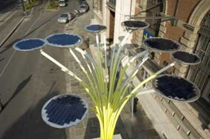Introducing the Solar Tree
 Vienna, Austria (Renewable Energy Access) - The streets of Europe could soon be lit by solar energy as a solar tree prototype recently passed a key test phase. The solar trees went on display for four weeks in October on a busy street — the Ringstrasse — in Vienna, Austria. They were able to provide enough light during the night-time even when the sun did not show for as much as four days in a row.
Vienna, Austria (Renewable Energy Access) - The streets of Europe could soon be lit by solar energy as a solar tree prototype recently passed a key test phase. The solar trees went on display for four weeks in October on a busy street — the Ringstrasse — in Vienna, Austria. They were able to provide enough light during the night-time even when the sun did not show for as much as four days in a row. “The solar cells on the tree were able to store enough electricity in spite of receiving no direct solar light for days at a time because of the clouds. They showed that solar trees really are a practical form of street lighting,” Christina Werner from Cultural Project Management (Kulturelles Projektmanagement, Vienna).
She said that the City of Vienna was now in the process of deciding whether to install more solar trees.
“We hope that not only the city of Vienna but other cities will see the merits of using renewable energy for street lighting to cut emissions,” Christina Werner said. “Someday soon solar trees could well be the main form of street lighting in Europe.”
Putting solar powered LED light systems on trees would cut down on the carbon emissions and also slash the bills of local authorities, she said.
Street lighting consumed 10 percent of all the electricity used in Europe in 2006 or 2,000 billion KWh, and resulted in carbon emissions of 2,900 million tonnes. The use of more energy-efficient lighting in the Austrian city of Graz, with a population of almost 300,000 saved the city 524,000 KWh of electricity and 67,200 euros [US $96,800] in 2005.
“Not just trees but other objects could be decorated with solar cells and so keep streets well lit at night time,” she said.
The branches of the solar tree were decorated with 10 solar lamps, each one comprising 36 solar cells. They also had rechargeable batteries and electronic systems. A sensor was used to measure the amount of light in the atmosphere which in turn would trigger the solar lamps to go on automatically at sunset and off at sunrise.
The tree was designed by Ross Lovegrove, a British designer, who said that they are not only efficient but also attractive and bring “nature into a gray city environment”.
An Italian company specializing in designer lighting systems, Artemide, as well as the world’s largest producer of photovoltaic (PV) cells, the German company Sharp Solar, joined forces to turn the design into reality.
The idea came from Peter Noever, the Director of the Austrian Museum for Applied Arts in Vienna (Österreichisches Museum fuer angewandte Kunst). Ross Lovegrove and Sharp are now working on the design study for a car that is powered by solar energy.
Sharp solar had a production volume of 434 megawatts in 2006 and a world market share of 17 percent. It produces PV cells in a factory in Katsuragi, Japan. Most of Sharp’s modules are used for solar energy systems on roofs, but the company believes that solar cells could soon be used in all areas of everyday life from clothes to satellites - including Christmas trees
You can return to the main Market News page, or press the Back button on your browser.

